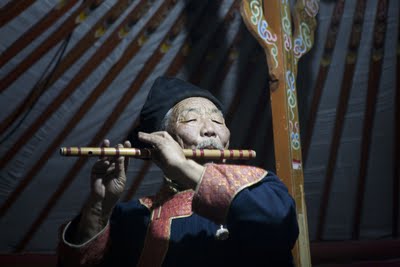Made from hollowed-out and sanded tree branches, the sound of the flute is meant to mimic the tones of waterfalls.
Horse-Head Fiddle (morin khuur)
Used in nearly every type of traditional performance, the horse-head fiddle resides at the core of Mongolia’s culture and national identity. Each fiddle has two braided strings made from hundreds of strands of horse tail hair; one represents male energy and the other female. It’s considered a symbol of Mongolia.
Lap Harp (yatga)
The harp was an instrument traditionally tied to status and was only played in monasteries. It’s 12 strings represent the orders within monasterial hierarchy.
_________
During an overnight stay near the Kharhorin Monastery, we were treated to a performance by the adorable Shuieen Aylguu. (Seriously, look at him!)
He had perfected his craft over decades and made a living performing and selling his music. And you know we came home with one his CDs (autographed no less!)
While the tones produced by each instrument differed greatly, there was one massive similarity – they were all hypnotic and relaxing.
We sat transfixed by the music, that is, almost transfixed. We were joined by an older solo-traveler (maybe mid-60’s) who clearly was not too big on personal hygiene. Let’s just say his presence was a slight olfactory distraction.
However, it wasn’t difficult to gather that the music was a direct reflection of Mongolian life; everything was in harmony, calm, slow and melodic.
Certainly, throat singing is a acquired taste, but knowing the skill and control needed to produce the bi-tonal melodies commanded our attention and respect.
*Some photos contributed by Conor O’Brien





Such interesting instruments! I can only imagine what being there and hearing them play was like. 😀
Hello,
nice review, but I have to say the flute on the first picture is not a “tsuur”, but a “limbe” or “limbi”, a transverse flute. “Tsuur” is an oblic, rim blown flute.
Best regards
C=’
Thanks for the correction! Regardless, I loved the sound of it.